Modern sport watches now analyze your running form through key metrics like cadence, ground contact time, vertical oscillation, and left/right balance. Premium models from Garmin, COROS, and Polar offer the most extensive data, while budget options provide basic measurements. Lower ground contact time (ideally 160-200ms) and reduced vertical oscillation (6-8cm) indicate better efficiency. You’ll spot imbalances before they cause injuries and make data-driven technique improvements. The right metrics can transform how you train.
Analyze Your Running Form With Sport Watches
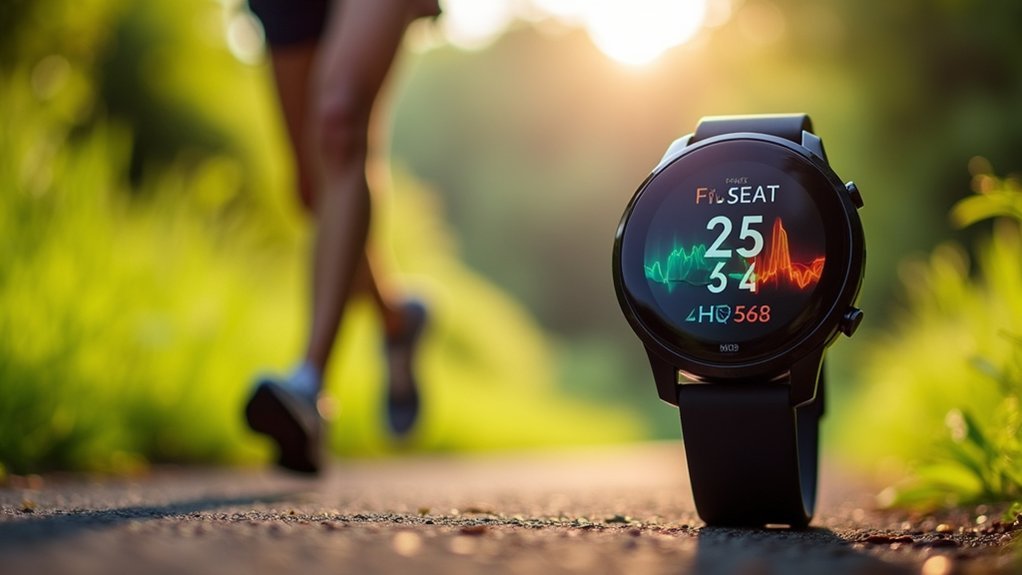
Modern sport watches have revolutionized how runners understand their biomechanics, turning complex gait analysis into accessible data. These devices track critical metrics including cadence (typically 163-185 steps per minute), vertical oscillation (experienced runners average 6cm versus beginners’ 10cm+), stride length, ground contact time, and left/right balance.
Leading brands offer varying capabilities: Garmin provides thorough wrist or chest-strap analysis with efficiency scoring; COROS requires a waist-mounted POD for its Running Form Test; Apple and Samsung offer basic metrics for casual runners; Huawei includes ground contact time; while Polar and Suunto integrate with third-party sensors for power data. Premium watches like the Polar Grit X2 Pro deliver dual-frequency GPS for superior accuracy in tracking your running routes and elevation changes.
For best results, pair your watch data with coaching input—wrist-only devices lack ground contact and balance metrics, and personal factors like height affect ideal cadence targets.
The Evolution of Wrist-Based Running Metrics
While today’s sport watches offer extensive running metrics, the path to this functionality reflects a remarkable technological journey. Your early running watch likely provided just basic GPS tracking for time, distance, and pace, requiring external sensors for detailed data.
The breakthrough came with integrated accelerometers, enabling watches to measure motion directly from your wrist. Garmin pioneered this technology, developing algorithms that translate arm movements into reliable estimates of cadence, stride length, vertical oscillation, and ground contact time.
Wrist-based accelerometers revolutionized running metrics, transforming simple GPS watches into sophisticated training tools through motion-sensing algorithms.
Recent advances have introduced power output measurement without external sensors, while software updates have democratized these features across multiple device generations. Pairing with compatible accessories like HRM-Fit or HRM-Pro series is still required to access all six running dynamics metrics.
This evolution means you’re now wearing a sophisticated biomechanical lab on your wrist, providing real-time feedback to adjust your form and optimize training efficiency.
Decoding Ground Contact Time and Balance
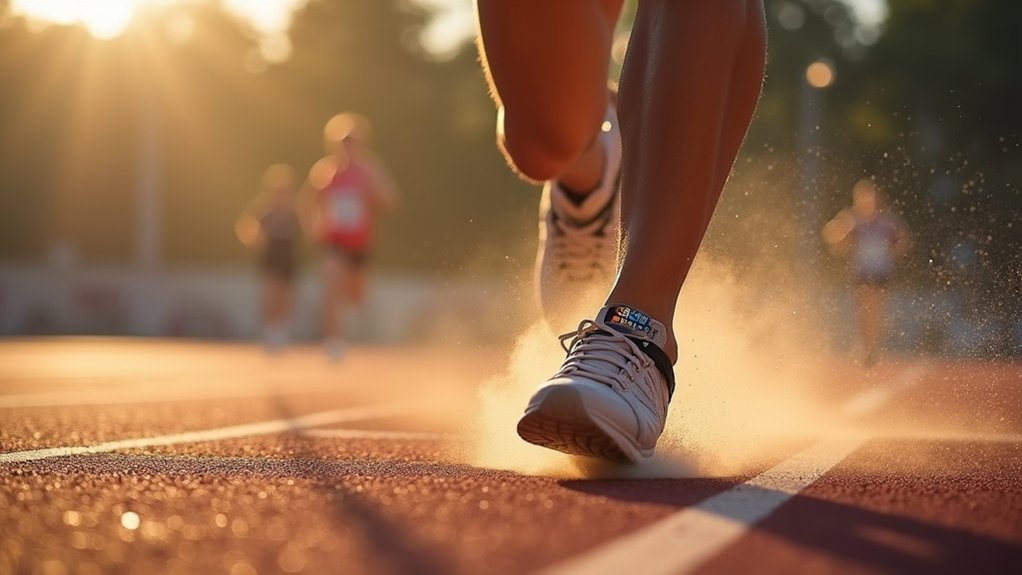
Each time your foot connects with the ground, it reveals critical insights about your running efficiency. Modern sport watches now track your ground contact time (GCT)—the milliseconds your foot spends on the ground during each step.
Elite runners maintain GCT between 160-200ms, while recreational runners often exceed 220ms. Lower GCT typically means reduced braking forces and better energy return, with each 10ms reduction saving roughly 1% energy per kilometer.
Your watch can also detect left/right imbalances in weight distribution. Aim for less than 2% difference between sides—anything above 5% signals potential injury risk. The Running Form Test evaluates these balance metrics as a key dimension of overall running economy.
Address asymmetries with single-leg strength exercises and cadence drills.
For most accurate readings, consider waist-mounted pods, especially when measuring balance during consistent-pace training runs.
Vertical Oscillation: What Your Bounce Reveals
Every step you take while running involves not just forward motion, but also a vertical component that can greatly impact your efficiency. This up-and-down movement, measured in centimeters by modern sport watches, is your vertical oscillation (VO).
Most runners bounce between 6-12cm per stride, with elite athletes maintaining an economical 6-8cm.
Your bounce reveals essential insights about your running economy:
- Higher oscillation (>10cm) indicates wasted energy moving upward instead of forward
- Lower oscillation (6-8cm) typically correlates with better efficiency and less fatigue
- Trending increases during runs often signal form breakdown from fatigue
- Too little bounce might cause inefficient shuffling gait
To track your vertical oscillation accurately, you’ll need compatible devices like the HRM-Pro™ heart monitor paired with specific Garmin watches.
Cadence Optimization for Injury Prevention

Closely related to your vertical bounce is how frequently your feet touch the ground. This metric, called cadence, markedly impacts your injury risk and running efficiency. Aim for approximately 170 steps per minute to reduce stress on your joints and muscles.
Your sport watch can track this vital metric in real-time, allowing you to make immediate adjustments. When you increase your cadence, you’ll experience shorter ground contact time, lower impact forces, and improved posture—all contributing to reduced injury risk.
To optimize your cadence, gradually increase your step rate by 5-10%. You’ll notice improved pace control, reduced muscle fatigue, and enhanced overall performance. Research consistently shows that shorter, quicker steps can significantly decrease overall muscle fatigue during your runs.
Combine cadence adjustments with appropriate footwear choices for best results, especially if you’re prone to shin splints or knee pain.
Budget vs. Premium Watches: Form Analysis Comparison
When comparing running watches, you’ll find budget models typically offer basic metrics while premium options deliver extensive form analysis through advanced sensors.
Your decision between value and features hinges on whether detailed running dynamics like pronation velocity and ground contact time are worth the investment.
Premium watches generally outperform budget alternatives in sensor accuracy and consistency, though recent improvements in affordable technology have narrowed this gap for casual runners. Dedicated GPS sports watches like the Garmin Enduro 3 provide more data tracking and extensive customization options compared to standard smartwatches.
Value Vs Features Matrix
Choosing between budget and premium running watches ultimately boils down to matching your analytical needs with your financial investment. Budget models deliver essential metrics like pace, cadence, and heart rate without exceeding $200, while premium watches offer extensive biomechanical analysis at $300-500+.
Consider these factors when determining watch value:
- Training goals – recreational runners benefit from basic metrics, while competitive athletes need advanced form analysis.
- Usage frequency – higher investment makes sense for daily training versus occasional runs. Models like the COROS Pace 2 offer excellent value with built-in running power capabilities at a budget-friendly price point.
- Battery requirements – budget watches cover standard workouts, but ultras demand premium battery life.
- Form feedback importance – if you’re working on technique corrections, premium watches’ real-time biomechanical feedback justifies the cost.
Sensor Equivalency Showdown
After weighing your budget considerations, the next question becomes: what actual technical differences separate a $150 watch from a $450 model when it comes to analyzing your running form?
Budget watches typically rely on basic accelerometers and gyroscopes that track only cadence and step count using generic algorithms.
You’ll experience signal drift under tree cover and need external pods for treadmill accuracy.
Premium models integrate multi-axis sensors with proprietary biomechanical models, capturing ground contact time, vertical oscillation, and left/right balance with >97% accuracy.
Their multi-band GPS maintains sub-3% distance error even in challenging terrain, while features like real-time form coaching and PacePro guidance provide immediate feedback. The sapphire glass and titanium construction found in high-end models like the Coros Vertix 2S ensure durability during intense training.
Post-run, premium platforms decompose metrics into muscle load and efficiency scores, linking form degradation to recovery recommendations.
How Accurate Are Wrist-Based Running Dynamics?
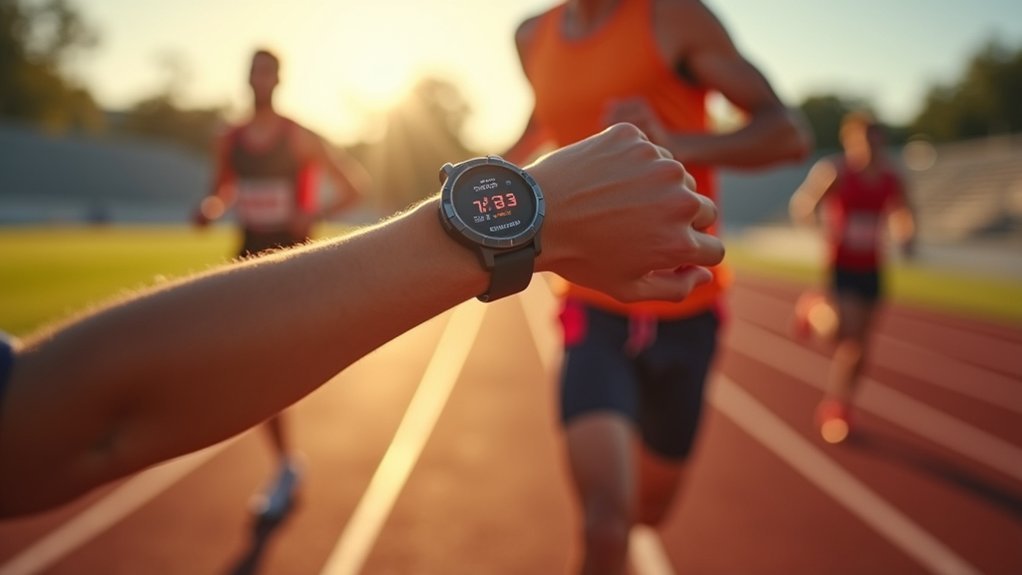
Just how reliable are those running metrics displayed on your wrist? While convenient, wrist-based running dynamics typically offer consistency rather than perfect accuracy. Your watch estimates metrics like vertical oscillation and ground contact time through wrist movement patterns, which can’t match the precision of specialized devices like chest straps or foot pods.
Environmental factors further complicate measurements:
- Elevation changes can confuse sensors and affect power readings
- Running style variations aren’t always accurately detected
- GPS limitations affect stride length calculations
- Atmospheric pressure fluctuations can skew measurements
Despite these limitations, recent updates have improved accuracy. Comparisons between devices show that a power reading divergence of 50-140 watts can occur when measuring the same run with different devices. For practical training purposes, the consistency of wrist measurements still provides valuable insights for improving your form and efficiency—even if absolute values differ from specialized equipment.
Chest Straps vs. Optical Sensors for Form Data
When you’re pushing at maximum effort, chest straps capture your heart rate with up to 98% correlation to medical-grade ECG, while optical sensors can drop to 89% accuracy due to motion artifacts.
Your device’s placement considerably influences data quality—chest straps maintain reliability through direct electrical signal capture regardless of movement intensity, while wrist sensors suffer from positioning issues and skin contact variations. The signal crossover phenomenon particularly affects wrist-based monitors during arm swing movements, leading to incorrect heart rate readings.
For the most reliable running form analytics that connect cardiovascular load with biomechanics, you’ll get superior results from a chest strap, especially when your training demands precision metrics for form correction and fatigue assessment.
Accuracy Under Max Effort
During high-intensity runs and maximum effort intervals, your heart rate monitor’s accuracy can greatly affect the quality of your form analysis data.
ECG-based chest straps consistently outperform optical sensors when you’re pushing your limits, providing more reliable metrics for analyzing running mechanics.
When you’re at maximum effort, consider these accuracy differences:
- Chest straps maintain stable readings during high-motion activities, while optical sensors often struggle.
- ECG technology offers 99% agreement with medical-grade equipment versus 93% for top wrist devices.
- The accuracy gap between technologies widens as your intensity increases.
- HRV data, essential for detailed performance analysis, is markedly more precise with chest straps.
While wrist-based options offer convenience, serious form analysis during intense workouts demands the gold-standard accuracy that chest straps provide. For advanced runners, chest straps can transmit detailed Running Dynamics data that optical sensors cannot capture.
Device Placement Matters
The position of your running sensors greatly impacts the quality and type of form data you’ll receive.
For extensive running form analysis, waist-mounted pods are superior, capturing critical metrics like balance, stride height, and ground contact time.
Wrist-based optical sensors, while convenient, primarily track heart rate and basic motion metrics but lack the precision needed for detailed biomechanical analysis.
They’re prone to motion artifacts and can’t accurately measure spatial gait parameters.
Chest straps excel at heart rate monitoring but fall short in providing running form metrics unless paired with additional sensors.
They simply don’t capture the stride mechanics needed for thorough form assessment.
For serious form analysis, choose specialized pods placed near your center of mass—they’ll deliver the most valid and reliable biomechanical data for improving your running technique.
The COROS POD should be worn securely on the waistband for accurate Running Form Test results that provide comprehensive evaluation of skill, strength, and balance metrics.
Interpreting Your Running Metrics Dashboard
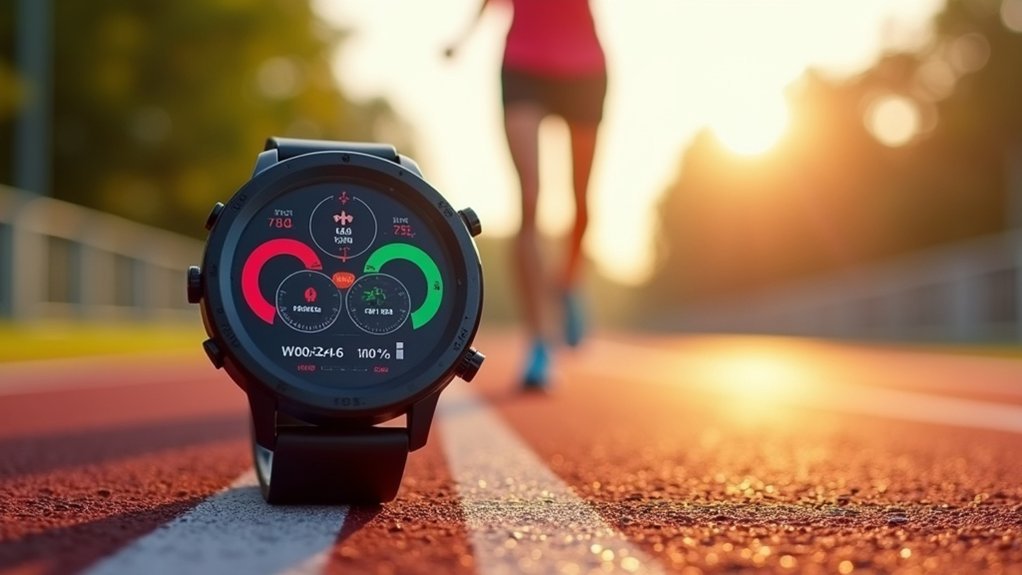
Modern running watches and apps collect an impressive array of data, but how do you make sense of all those numbers on your dashboard? Focus on understanding how metrics work together rather than viewing them in isolation.
For maximum insight from your running dashboard:
- Analyze pace alongside heart rate to gauge effort levels—what feels easy should match appropriate heart rate zones.
- Compare cadence with stride length to optimize your running economy—aim for 170-180 steps per minute.
- Evaluate vertical oscillation and ground contact time together to identify form inefficiencies.
- Track your rolling mile pace against elevation gain to understand performance on varied terrain.
Customize your watch display to show metrics most relevant to your current training goals, and regularly review historical data to spot improvement patterns. Watches like the Garmin Forerunner 265 offer multi-band GPS for exceptionally accurate tracking when analyzing your metrics across different environments.
Battery Management During Form Analysis Sessions
While analyzing your running form provides valuable insights, effective battery management guarantees you’ll capture complete data throughout your session. Continuous GPS usage and sensor data collection are the primary power drains during form analysis.
To extend battery life, consider using UltraTrac mode for longer runs, though this reduces location accuracy. Disable non-essential features like music playback and WiFi, and lower screen brightness or turn it off entirely. Most mid-range watches offer 19-26 hours of GPS runtime—enough for multiple analysis sessions. Modern sports watches now include specialized features to evaluate running form and cadence to improve technique and reduce injury risk.
For extended outdoor training, carry a portable power bank or plan interval sessions that alternate between intensive form analysis and basic tracking.
Newer watches with advanced power management can optimize GPS sampling rates based on your movement patterns, balancing accuracy with battery conservation.
Data Syncing Options for In-Depth Form Review
Once you’ve collected valuable running form data, efficiently syncing this information becomes essential for meaningful analysis.
Your sport watch offers several pathways to transfer biomechanical metrics to platforms where you can properly evaluate them.
Choose from these syncing methods based on your needs:
- Native integrations – Connect your Garmin or other device directly to apps like Strava for automatic one-way transfers of cadence and stride data.
- Cloud-based aggregators – Access your form metrics across multiple devices through platforms that sync whenever your watch connects.
- Custom solutions – Utilize two-way synchronization for advanced analysis when standard options don’t provide enough depth.
- Real-time options – Review form parameters immediately post-run for timely adjustments to your technique.
Effective synchronization provides a unified view of your running data across multiple devices, allowing coaches and athletes to collaborate with consistent information.
Real-World Applications of Running Form Data
Running form data offers immediate value through asymmetry detection that helps you prevent injuries before they occur.
Your marathon pacing becomes more scientific when you optimize based on stance time and vertical oscillation patterns collected during training runs. For an even more comprehensive approach, consider utilizing smartphone-based analysis tools that deliver detailed personalized insights tailored to your height, weight, gender, and running speed.
Trail runners can use this data to adapt their technique for varied terrain, improving efficiency when maneuvering around roots, rocks, and elevation changes.
Injury Prevention Through Asymmetry
As technology advances, your sport watch has become more than just a timekeeper—it’s now a powerful tool for injury prevention through asymmetry detection.
While healthy runners typically maintain less than 3% asymmetry, exceeding 5% notably increases injury risk. Your watch tracks essential metrics like ground contact time, stride length, and limb loading, highlighting imbalances before they cause damage. The data helps identify if you’re developing compensatory movement patterns that may result from previous injuries.
When your watch detects asymmetry, consider these targeted interventions:
- Implement single-leg strength exercises focusing on your weaker side
- Add hip drive and tendon-strengthening movements to your routine
- Use watch data to guide neuromuscular retraining for better proprioception
- Incorporate mobility drills addressing specific flexibility imbalances
This continuous monitoring helps you adapt training loads based on objective biomechanical evidence, preventing injuries before they occur.
Marathon Pacing Optimization
How effectively you manage your energy throughout 26.2 miles often determines marathon success more than raw fitness alone. Your sport watch becomes an invaluable pacing coach when programmed strategically.
Elite runners typically employ even pacing or negative splits, finishing stronger than they start. Consider implementing the 10/10/10 method: run the first 10 miles slightly below goal pace, maintain steady effort for the middle 10, then push through the final 6.2 miles.
Begin 10-15 seconds slower than goal pace for the initial miles, allowing your body to warm up properly. This conservative approach helps prevent the premature fatigue that commonly occurs when runners get swept up in start-line excitement. Your watch can alert you if you’re starting too fast—a common mistake that derails marathon performances.
For ideal training, program your device to track gradual progression within long runs, simulating race-day strategy and building the muscle memory needed for disciplined pacing.
Trail Running Adaptations
When trail running demands quick adaptations to diverse terrain, your running form must evolve beyond road-running mechanics. Your GPS watch becomes an essential form coach, providing real-time feedback as you navigate rocky descents and steep climbs.
Modern trail watches analyze your cadence, vertical oscillation, and ground contact time across various terrain types. Accurate data collection requires watches with multiple satellite systems to maintain precise tracking even under dense forest canopy.
For ideal trail running form:
- Increase your knee lift and shorten your stride length by 10-15% on technical sections
- Shift to a midfoot or forefoot strike when descending to improve stability
- Maintain a cadence between 170-180 steps per minute even on challenging terrain
- Monitor your vertical oscillation data to reduce unnecessary bouncing and conserve energy
Post-run analysis helps identify form breakdowns on specific trail segments, allowing you to develop terrain-specific strength routines.
Training Programs Based on Form Metrics
While traditional running programs focus primarily on mileage and pace, modern training approaches now incorporate sophisticated form metrics to create truly personalized plans. Your watch data like cadence, ground contact time, and stride length can reveal areas for targeted improvement.
These programs emphasize individualized optimization rather than a one-size-fits-all ideal form. You’ll progress through structured difficulty levels, making small, incremental adjustments to your natural mechanics. Training focuses specifically on your weaknesses—if your ground contact time balance shows asymmetry, you’ll address it with unilateral exercises. Modern training protocols aim to increase your Running Smoothness™ value, which directly correlates with lower impact forces on your body.
Platforms like Movaia allow you to upload running videos for expert analysis, while devices such as COROS watches provide composite form scores.
This tech-driven approach helps you build strength in specific muscle groups, refine posture, and optimize cadence for better efficiency.
Frequently Asked Questions
Can Running Watches Detect Potential Injuries Before They Occur?
Yes, your running watch can detect potential injuries by monitoring biomechanical metrics, providing real-time feedback, and tracking cumulative load patterns that indicate injury risk before symptoms appear. You’ll receive early warning signs.
How Does Weather Affect the Accuracy of Biomechanical Measurements?
Weather can markedly affect your biomechanical measurements. Temperature changes sensor reliability, humidity impacts data quality, and environmental conditions alter your running form. You’ll notice less accurate readings during extreme weather conditions.
Can Watches Track Changes in Running Form as Fatigue Sets In?
Yes, your watch can track form changes during fatigue. It monitors cadence drops, increased ground contact time, reduced stride length, and asymmetrical movements. Heart rate patterns also reveal how fatigue affects your running mechanics.
Do Running Watches Work Accurately on Treadmills for Form Analysis?
Running watches are less accurate on treadmills for form analysis. You’ll see discrepancies due to calibration issues, but they still track cadence and arm swing effectively. For best results, use outdoor calibration first.
How Do Different Running Surfaces Affect Biomechanical Metrics?
Different surfaces impact your biomechanical metrics considerably. Hard surfaces like concrete increase impact forces but return energy quickly, while softer surfaces like grass reduce joint stress but extend your ground contact time.
In Summary
You’ve entered a new era of running where your watch isn’t just tracking distance and pace, but actively coaching your form. By regularly monitoring these metrics, you’ll prevent injuries, boost efficiency, and reveal your true potential. Make these insights part of your training routine, and you’ll transform your running from the ground up. The perfect stride is now literally at your wrist.

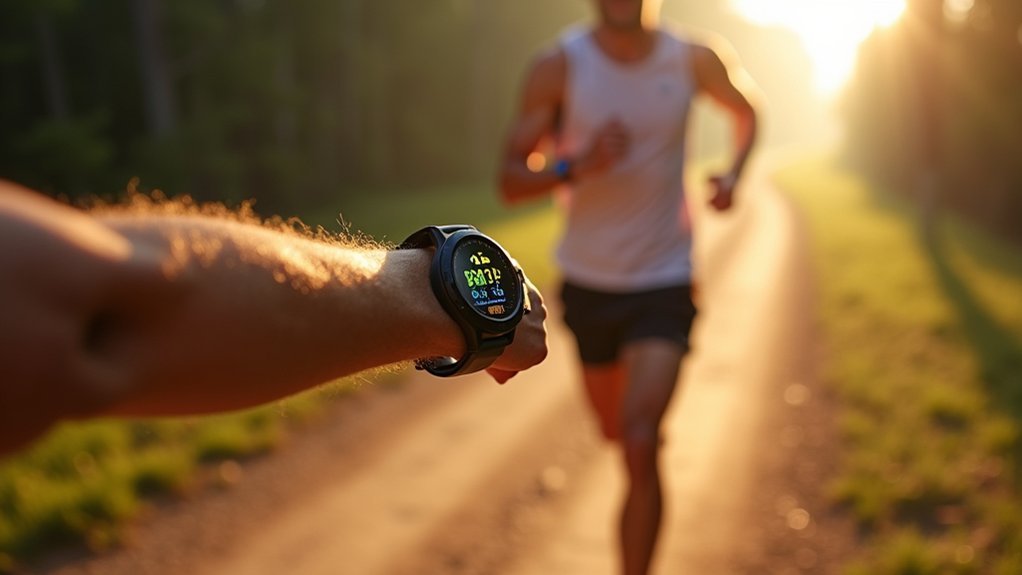



Leave a Reply